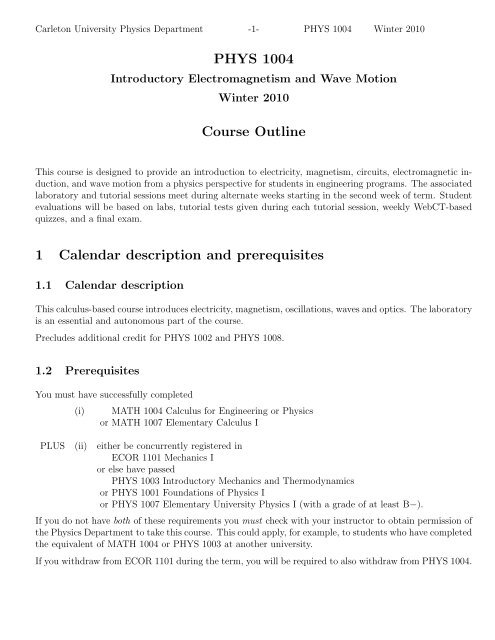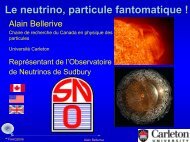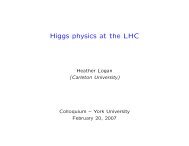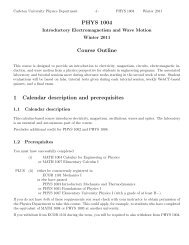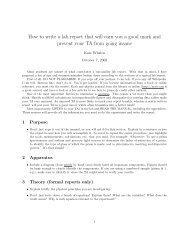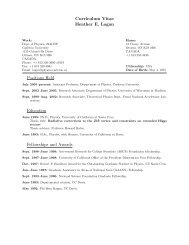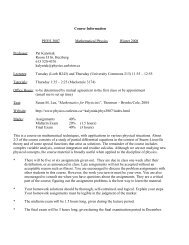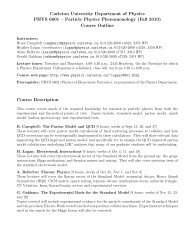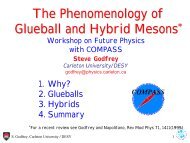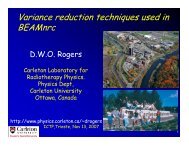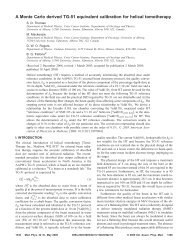PHYS 1004 Course Outline 1 Calendar description and prerequisites
PHYS 1004 Course Outline 1 Calendar description and prerequisites
PHYS 1004 Course Outline 1 Calendar description and prerequisites
Create successful ePaper yourself
Turn your PDF publications into a flip-book with our unique Google optimized e-Paper software.
Carleton University Physics Department -1- <strong>PHYS</strong> <strong>1004</strong> Winter 2010<br />
<strong>PHYS</strong> <strong>1004</strong><br />
Introductory Electromagnetism <strong>and</strong> Wave Motion<br />
Winter 2010<br />
<strong>Course</strong> <strong>Outline</strong><br />
This course is designed to provide an introduction to electricity, magnetism, circuits, electromagnetic induction,<br />
<strong>and</strong> wave motion from a physics perspective for students in engineering programs. The associated<br />
laboratory <strong>and</strong> tutorial sessions meet during alternate weeks starting in the second week of term. Student<br />
evaluations will be based on labs, tutorial tests given during each tutorial session, weekly WebCT-based<br />
quizzes, <strong>and</strong> a final exam.<br />
1 <strong>Calendar</strong> <strong>description</strong> <strong>and</strong> <strong>prerequisites</strong><br />
1.1 <strong>Calendar</strong> <strong>description</strong><br />
This calculus-based course introduces electricity, magnetism, oscillations, waves <strong>and</strong> optics. The laboratory<br />
is an essential <strong>and</strong> autonomous part of the course.<br />
Precludes additional credit for <strong>PHYS</strong> 1002 <strong>and</strong> <strong>PHYS</strong> 1008.<br />
1.2 Prerequisites<br />
You must have successfully completed<br />
(i)<br />
or MATH <strong>1004</strong> Calculus for Engineering or Physics<br />
or MATH 1007 Elementary Calculus I<br />
PLUS (ii) either be concurrently registered in<br />
or ECOR 1101 Mechanics I<br />
or else have passed<br />
or <strong>PHYS</strong> 1003 Introductory Mechanics <strong>and</strong> Thermodynamics<br />
or <strong>PHYS</strong> 1001 Foundations of Physics I<br />
or <strong>PHYS</strong> 1007 Elementary University Physics I (with a grade of at least B−).<br />
If you do not have both of these requirements you must check with your instructor to obtain permission of<br />
the Physics Department to take this course. This could apply, for example, to students who have completed<br />
the equivalent of MATH <strong>1004</strong> or <strong>PHYS</strong> 1003 at another university.<br />
If you withdraw from ECOR 1101 during the term, you will be required to also withdraw from <strong>PHYS</strong> <strong>1004</strong>.
Carleton University Physics Department -2- <strong>PHYS</strong> <strong>1004</strong> Winter 2010<br />
2 Who teaches the course, when <strong>and</strong> where<br />
2.1 Lecture Timetable<br />
CRN Section Times Room Lecturer Lecturer’s office & contact info<br />
10923 A Mon 10:00–11:30 AT 102 Bruce Campbell Herzberg 3378<br />
Wed 10:00–11:30<br />
campbell@physics.carleton.ca<br />
613-520-2600 x4322<br />
14859 B Tue 19:30–21:00 AT 102 David Asner Herzberg 2410<br />
Thu 19:30–21:00<br />
asner@physics.carleton.ca<br />
613-520-2600 x8996<br />
10927 C Tue 16:30–18:00 AT 102 Heather Logan Herzberg 2450<br />
Thu 16:30–18:00 (course logan@physics.carleton.ca<br />
coordinator) 613-520-2600 x4319<br />
10930 M Tue 18:00–19:30 AT 102 Peter Krug Herzberg 3368<br />
Thu 18:00–19:30<br />
pkrug@physics.carleton.ca<br />
613-520-2600 x8922<br />
2.2 Laboratory <strong>and</strong> Tutorial Timetable<br />
CRN Section Time<br />
10924 A1 Thu 8:30–11:30<br />
10925 A3 Tue 8:30–11:30<br />
10926 A5 Tue 14:30–17:30<br />
14860 B6 Thu 14:30–17:30<br />
14861 B7 Mon 10:00–13:00<br />
14863 B8 Wed 8:30–11:30<br />
10933 C2 Wed 14:30–17:30<br />
10931 C4 Mon 14:30–17:30<br />
10928 C9 Fri 14:30–17:30<br />
Room:<br />
Lab supervisor:<br />
Herzberg 4130 (all sections)<br />
Igor Ivanovic<br />
Supervisor’s office Herzberg 3346<br />
& contact info: igor@physics.carleton.ca<br />
613-520-2600 x5796<br />
10932 M11 Wed 18:00–21:00<br />
11703 M13 Mon 18:00–21:00
Carleton University Physics Department -3- <strong>PHYS</strong> <strong>1004</strong> Winter 2010<br />
3 Learning outcomes<br />
In the process of successfully completing this course, you will learn how to:<br />
• solve multi-step problems;<br />
• present written solutions to problems in a clear <strong>and</strong> logical way;<br />
• apply calculus techniques to real physical problems;<br />
• underst<strong>and</strong> the concepts of electric <strong>and</strong> magnetic fields <strong>and</strong> the associated forces;<br />
• relate the motion of objects in electric fields to familiar concepts of force, work, <strong>and</strong> kinetic <strong>and</strong><br />
potential energy;<br />
• determine the electric field <strong>and</strong> electric potential due to a known charge distribution using Coulomb’s<br />
law, Gauss’s law, <strong>and</strong> the relationship between electric field <strong>and</strong> potential;<br />
• use the electric field <strong>and</strong> potential formalism to underst<strong>and</strong> capacitors;<br />
• underst<strong>and</strong> electric current <strong>and</strong> the rules for modeling electric circuits from a physics perspective;<br />
• determine the magnetic field due to a known current distribution using the Biot-Savart law <strong>and</strong><br />
Ampère’s law;<br />
• determine the forces on moving charges <strong>and</strong> current-carrying wires due to an external magnetic field,<br />
<strong>and</strong> underst<strong>and</strong> the technological applications of these forces, e.g., in the electric motor <strong>and</strong> electric<br />
generator;<br />
• underst<strong>and</strong> electromagnetic induction, determine the resulting induced currents, <strong>and</strong> underst<strong>and</strong><br />
their consequences;<br />
• underst<strong>and</strong> oscillatory motion using the simple mass-on-a-spring model;<br />
• analyze alternating-current (AC) circuits from a physics perspective;<br />
• underst<strong>and</strong> travelling waves with special emphasis on electromagnetic waves; <strong>and</strong><br />
• analyze the effect of polarizing filters on electromagnetic waves.<br />
In the laboratory portion of this course you will learn how to:<br />
• present the results of laboratory experiments in a clear <strong>and</strong> well-organized written form;<br />
• quantify experimental uncertainties;<br />
• construct circuits from electronic components;<br />
• measure currents <strong>and</strong> voltages in circuits using common measuring devices;<br />
• use an oscilloscope for analysis of electronic signals; <strong>and</strong><br />
• underst<strong>and</strong> the behaviour of direct-current (DC) circuits, resistor-capacitor (RC) circuits, <strong>and</strong> the<br />
use of optical lenses.
Carleton University Physics Department -4- <strong>PHYS</strong> <strong>1004</strong> Winter 2010<br />
4 How to succeed in this course<br />
4.1 Tips for success<br />
• Study effectively. The only way to learn physics is by working the problems. Work <strong>and</strong> rework<br />
all the examples in the text <strong>and</strong> the assigned homework problems. If you can do all the homework<br />
problems by yourself with only the attached formula sheet as an aid, then you’re on the road to a<br />
good mark in the course.<br />
• Do your homework. Aim to work through all the assigned homework problems before your<br />
tutorial. That way you will know what areas you need to focus on during the tutorial when working<br />
in groups <strong>and</strong> getting help from the TAs. Each tutorial test will include a long-answer problem based<br />
on one of the homework problems, so be prepared!<br />
• Take advantage of class time. Attend all the lectures, participate in class discussions <strong>and</strong> exercises,<br />
take notes, <strong>and</strong> don’t be afraid to ask questions. When taking notes, concentrate on the things<br />
that your instructor emphasizes on the chalkboard or slides.<br />
• Use your textbook. Read the assigned sections of the textbook before each class. Review them<br />
again after class <strong>and</strong> annotate your class notes as needed. At the end of each chapter of the textbook<br />
is a one- or two-page review of the important concepts covered in each chapter.<br />
• Get all the term marks you can. Attend all the tutorials <strong>and</strong> be prepared for the tutorial tests.<br />
Attend all the labs <strong>and</strong> turn in all your lab reports on time. Do all the WebCT quizzes on your own<br />
<strong>and</strong> before the deadline. (Note that it is easy to work in groups on the WebCT quizzes <strong>and</strong> get all<br />
the answers from your friends, but this defeats the purpose of learning by doing these problems <strong>and</strong><br />
it will not prepare you for the final exam. The final exam will have many similar problems which are<br />
worth twice as many marks as all the WebCT quizzes put together.)<br />
• Get help if you need it. If you’re having trouble with a concept or homework problem, go to your<br />
instructor’s office hours or the Drop-In Centre for help. We are here to help you learn!<br />
4.2 Getting help<br />
• Office hours: Each of the course instructors will hold office hours a couple times per week. Times<br />
<strong>and</strong> locations will be posted in WebCT <strong>and</strong> announced in class. The instructors can also be reached<br />
by email.<br />
• Drop-In Centre: The Physics Department runs a Drop-In Centre staffed by TAs for help in firstyear<br />
Physics courses. The times <strong>and</strong> location will be posted in WebCT <strong>and</strong> announced in class.
Carleton University Physics Department -5- <strong>PHYS</strong> <strong>1004</strong> Winter 2010<br />
5 <strong>Course</strong> components <strong>and</strong> marking scheme<br />
5.1 Marks <strong>and</strong> passing conditions<br />
The marking scheme is as follows:<br />
Theory (total 70%) Weekly WebCT quizzes (best 9 of 11) 10%<br />
Tutorial Tests (best 4 of 5) 25%<br />
Final Exam 35%<br />
Lab Experiments 30%<br />
<strong>Course</strong> total 100%<br />
In order to pass the course, you overall mark must be greater than 50% AND you must achieve 40% or<br />
above on BOTH the Theory AND the Lab Experiments components of the course.<br />
Students with an overall course mark above 50% but who achieve between 40% <strong>and</strong> 49% on either Lab<br />
Experiments or Theory will be given a grade of D−, no matter how good their overall mark is.<br />
5.2 Weekly WebCT quizzes<br />
Each week you will have a brief, WebCT-based quiz consisting mostly of conceptual questions or questions<br />
requiring a brief calculation. The purpose of these quizzes is to help you learn the material <strong>and</strong> verify your<br />
basic underst<strong>and</strong>ing before you move on to the more complicated homework problems associated with the<br />
Tutorials. Each week there will be a Self Quiz that you can do for practice as many times as you like, <strong>and</strong><br />
a time-limited Quiz that will be graded. You should read the relevant textbook sections before you start<br />
the time-limited Quiz. The quizzes are open-book. Have lots of scratch paper h<strong>and</strong>y while doing the quiz:<br />
even simple calculations are much easier when done on paper than in your head.<br />
There are many ways to subvert the purpose of these quizzes (e.g., working in groups, copying answers).<br />
Note though that 60% of the final exam will be made up of similar problems <strong>and</strong> it is in your interest to<br />
put in the effort to learn the material <strong>and</strong> do the quizzes well by yourself.<br />
WebCT quizzes are under the “Assessments” section of the WebCT page <strong>and</strong> will be due at 16:00 on<br />
Fridays. It is your responsibility to complete the quiz by the deadline. There is no way to make up a missed<br />
quiz once the deadline has passed. If you have a legitimate technical problem (browser crash, internet<br />
failure) <strong>and</strong> you contact us by email before the deadline, we can reset your quiz for you to start fresh.<br />
Solutions to the WebCT quizzes will be posted shortly after the deadline. You should review the solutions<br />
to be sure you underst<strong>and</strong> the answers.<br />
Your best 9 out of the 11 WebCT quizzes will make up 10% of your overall course mark.<br />
5.3 Tutorials<br />
There are 5 Tutorials in the term. They take place in your regular lab time slot in Herzberg 4130,<br />
alternating weeks with the labs. The Tutorial schedule is given in Sec. 8. During the first two hours of<br />
the Tutorial you will work on problems <strong>and</strong> have the opportunity to ask questions of the TAs. Working<br />
in groups is encouraged. During the last hour of the Tutorial will be a 45-minute Test which you do on<br />
your own <strong>and</strong> h<strong>and</strong> in for marking. The Test will consist of 3 to 5 multiple choice questions plus one or
Carleton University Physics Department -6- <strong>PHYS</strong> <strong>1004</strong> Winter 2010<br />
possibly two questions requiring written solutions. Your best 4 out of the 5 Tutorial Tests will make up<br />
25% of your overall course mark.<br />
The Tutorial Tests (<strong>and</strong> the final exam) will be based on the homework problems given in Sec. 7. It is<br />
thus important that you prepare the homework problems prior to the Tutorial <strong>and</strong> use the Tutorial time<br />
to underst<strong>and</strong> these problems well.<br />
Solutions to the Tutorial Tests will be posted in the notice board outside the lab (Herzberg 4130) at the<br />
end of each Tutorial week.<br />
What to bring: Bring your student ID card, writing instruments, <strong>and</strong> a calculator, plus a ruler if you<br />
want. No other aids are allowed for the Tests. The formula sheets that make up the last two pages of this<br />
course outline will be provided to you with the Test.<br />
Attend your own Tutorial section only. To be able to write the Test in a different section, you must<br />
obtain written permission from your lecturer on a st<strong>and</strong>ard form. Such permission will usually be granted<br />
only for emergencies or medical reasons, or official activities such as Engineers Without Borders.<br />
Tutorial Test make-ups: If you miss a Tutorial Test, immediately contact your lecturer <strong>and</strong> explain<br />
why. If the reason is illness, a doctor’s note is required. Students with valid reasons will be given written<br />
permission to write the test in a different section later the same week if possible. If this is not possible, you<br />
must obtain permission to write a make-up test at the end of term. These will all be written on Wednesday<br />
April 7 (during the review period); the time will be announced toward the end of term. Note that you<br />
need to get permission at the time you miss the test or as soon as you are back at school after an illness<br />
or accident. Retroactive permission will not be given at the end of term.<br />
5.4 Labs<br />
Labs start during the second week of term (January 11–15). Bring your copy of the lab manual <strong>and</strong> a<br />
blank beige lab booklet with you to the first lab. For each lab you will be writing a lab report. Some of<br />
these will be Short Reports while others will be Formal Reports. Instructions on writing lab reports will<br />
be given during the lab. Lab reports will usually be due at the start of the next lab (not at Tutorials),<br />
with the exception of the last two labs for which the report will be written up <strong>and</strong> turned in before the<br />
end of the lab period.<br />
For students repeating this course, you may request to be exempt from the lab (<strong>and</strong> have your lab mark<br />
carried forward from before) if you have completed all the lab experiments with a sufficiently high mark.<br />
You must contact Dr. Ivanovic <strong>and</strong> obtain explicit permission to be exempt from the lab. Note that you<br />
will not be exempted from the Tutorials, which meet in alternate weeks during your lab period.<br />
5.5 Final Exam<br />
The Final Exam will be held during the exam period, April 8–24 (including Saturdays)—the date will be<br />
announced by the university by February 12. All four lecture sections will write the Final Exam together.<br />
You may bring only writing implements, a calculator, <strong>and</strong> a ruler to the Final Exam. The formula sheets<br />
that make up the last two pages of this course outline will be provided. The Final Exam will include<br />
four problems requiring written solutions, of which you will choose three to do. These problems will be<br />
based on the assigned Homework Problems. The exam will also include a few questions relevant to the<br />
laboratory.
Carleton University Physics Department -7- <strong>PHYS</strong> <strong>1004</strong> Winter 2010<br />
If you miss the Final Exam for a good reason such as illness, you may apply for a Deferred Exam through<br />
the registrar’s office. A Deferred Exam replaces only the Final Exam portion of your mark. Deferred<br />
Exams for Winter 2010 will be scheduled during June 12–23. In order to be eligible for a Deferred Exam<br />
you must have earned at least 7 out of the possible 35 marks on term work in the theory component of<br />
the course (i.e., the Tutorial Tests <strong>and</strong> WebCT quizzes) <strong>and</strong> at least 12 out of the possible 30 lab marks.<br />
6 Required textbook <strong>and</strong> materials<br />
Textbook: R<strong>and</strong>all D. Knight, Physics for Scientists <strong>and</strong> Engineers, (Pearson Addison-Wesley, 2007),<br />
ISBN 0-136-10696-X. [Available at the Bookstore (Uni Centre) <strong>and</strong> at Haven Books.]<br />
This is a custom printing specifically for Carleton University containing the chapters we will cover. It is<br />
based on the 2nd edition of the text. If you buy it used, it may be missing a 3-page insert on the vector<br />
cross product, which we can give you.<br />
Lab manual: Laboratory Manual for <strong>PHYS</strong> <strong>1004</strong>, Winter 2004 edition or more recent.<br />
[Available at Science Stores, 118 Steacie Building.]<br />
You must bring this with you to each Lab session.<br />
Lab booklets: Five (5) beige booklets, Carleton University Laboratory Report.<br />
[Available at the Bookstore (Uni Centre).]<br />
You must bring one with you to each Lab session.
Carleton University Physics Department -8- <strong>PHYS</strong> <strong>1004</strong> Winter 2010<br />
7 Homework problems<br />
The following problems, from Knight, are assigned as homework. You should attempt to complete them<br />
before the corresponding Tutorial. They will not be collected; instead, the Tutorial Test during the last<br />
hour of each Tutorial will be based on these assigned problems. During the first 2 hours of each Tutorial<br />
you will work on these problems in groups <strong>and</strong> be able to ask questions of the tutorial TAs. This is your<br />
opportunity to clear up any remaining questions on the material before the Tutorial Test. The last set of<br />
problems, on material covered during the last two weeks of term, will not be on a Tutorial Test but are<br />
fair game for the final exam.<br />
Tutorial 1:<br />
Ch. 3 EP# 23, 25, 39, 45<br />
Ch. 10 EP# 5, 37, 41, 51, 55<br />
Ch. 11 EP# 1, 7, 11, 41, 42, 43, 44<br />
Ch. 26 EP# 15, 25, 32, 48, 60, 63<br />
Tutorial 2:<br />
Ch. 27 EP# 3, 9, 30, 43, 47, 53<br />
Ch. 28 EP# 1, 2, 29, 30, 39, 48, 52, 53<br />
Tutorial 3:<br />
Ch. 29 EP# 52, 63, 70, 72<br />
Ch. 30 EP# 44, 61, 67, 71<br />
Ch. 31 EP# 17, 39, 41, 45, 63, 67<br />
Tutorial 4:<br />
Ch. 32 EP# 17, 29, 33, 63, 69, 73<br />
Ch. 33 EP# 5, 11, 17, 43, 49, 55, 66<br />
Tutorial 5:<br />
Ch. 34 EP# 28, 31, 37, 38, 40, 52, 59, 79, 80<br />
Ch. 14 EP# 5, 13, 33, 36<br />
Remaining course material:<br />
Ch. 36 EP# 19, 35, 40, 43, 47, 61<br />
Ch. 20 EP# 7, 13, 27, 41, 42, 45<br />
Ch. 35 EP# 17, 21, 25, 27<br />
Note: EP = Exercises <strong>and</strong> Problems. You should also try to do all of the Conceptual Questions at the end<br />
of each chapter.
Carleton University Physics Department -9- <strong>PHYS</strong> <strong>1004</strong> Winter 2010<br />
8 Schedule of lectures, labs, <strong>and</strong> tutorials<br />
8.1 Schedule<br />
Week<br />
Activities<br />
Week 1 (Jan 4–8) Lectures 1 <strong>and</strong> 2<br />
No lab or tutorial<br />
WebCT Quiz 1 due at 16:00 on Friday<br />
Week 2 (Jan 11–15) Lectures 3 <strong>and</strong> 4<br />
Lab: Intro to the Lab; Error Analysis;<br />
Lab: Introduction to DC Circuits (15% of your lab mark;<br />
Lab: Short Report due at start of next lab)<br />
WebCT Quiz 2 due at 16:00 on Friday<br />
Fri Jan 15 is the last day to change courses or sections<br />
Week 3 (Jan 18–22) Lectures 5 <strong>and</strong> 6<br />
Tutorial 1<br />
WebCT Quiz 3 due at 16:00 on Friday<br />
Week 4 (Jan 25–29) Lectures 7 <strong>and</strong> 8<br />
Lab: Kirchhoff’s Rules (15% of your lab mark;<br />
Lab: Short Report due at start of next lab)<br />
Lab: DC Circuits lab report due at start of lab<br />
WebCT Quiz 4 due at 16:00 on Friday<br />
Week 5 (Feb 1–5) Lectures 9 <strong>and</strong> 10<br />
Tutorial 2<br />
WebCT Quiz 5 due at 16:00 on Friday<br />
Week 6 (Feb 8–12) Lectures 11 <strong>and</strong> 12<br />
Lab: RC Time Constant (25% of your lab mark;<br />
Lab: Formal Report due at start of next lab)<br />
Lab: Kirchhoff’s Rules lab report due at start of lab<br />
WebCT Quiz 6 due at 16:00 on Friday<br />
The final exam schedule will be available by Fri Feb 12<br />
Reading Week (Feb 15–19)<br />
No lectures, labs, or tutorials<br />
Week 7 (Feb 22–26) Lectures 13 <strong>and</strong> 14<br />
Tutorial 3<br />
WebCT Quiz 7 due at 16:00 on Friday<br />
Week 8 (Mar 1–5) Lectures 15 <strong>and</strong> 16<br />
Lab: Oscilloscope part 1<br />
Lab: RC Time Constant lab report due at start of lab<br />
WebCT Quiz 8 due at 16:00 on Friday
Carleton University Physics Department -10- <strong>PHYS</strong> <strong>1004</strong> Winter 2010<br />
Week<br />
Activities<br />
Week 9 (Mar 8–12) Lectures 17 <strong>and</strong> 18<br />
Tutorial 4<br />
WebCT Quiz 9 due at 16:00 on Friday<br />
Fri Mar 12 is the last day to withdraw from a course<br />
Week 10 (Mar 16–19) Lectures 19 <strong>and</strong> 20<br />
Lab: Oscilloscope part 2 (25% of your lab mark;<br />
Lab: Short Report due at the end of this lab period)<br />
WebCT Quiz 10 due at 16:00 on Friday<br />
Week 11 (Mar 22–26) Lectures 21 <strong>and</strong> 22<br />
Tutorial 5<br />
WebCT Quiz 11 due at 16:00 on Friday<br />
Week 12 (Mar 29–Apr 2) Lectures 23 <strong>and</strong> 24<br />
Lab: Simple Lens (20% of your lab mark;<br />
Lab: Short Report due at the end of this lab period)<br />
Note Fri Apr 2 is a holiday <strong>and</strong> Mon Apr 5 follows a Friday schedule.<br />
If you have a Friday lab, it will meet on Mon Apr 5 at your usual lab time.<br />
Review period (Apr 6–7)<br />
Lecture review session<br />
Tutorial Test make-ups (Apr 7; for those given written permission during term)<br />
Lab make-ups (for those given permission during term)
Carleton University Physics Department -11- <strong>PHYS</strong> <strong>1004</strong> Winter 2010<br />
8.2 Material to be covered in each lecture<br />
To make best use of limited lecture time, lectures will concentrate on the more difficult material, while the<br />
simpler introductory material will be left for you to read <strong>and</strong> underst<strong>and</strong> by yourself. This material is still<br />
examinable, even though it will be covered in less detail in lectures.<br />
You should always read all the sections of the textbook to be covered before coming to class.<br />
Textbook sections<br />
Lecture Topic Covered today Self study<br />
1, 2 Intro to the course; vectors, kinetic <strong>and</strong> potential Ch. 3 (all), Ch. 3<br />
energy, Hooke’s law Ch. 10.1–10.5<br />
3 Basic energy model, work & kinetic energy, forces, Ch. 11.1–11.5, 11.1, 11.9<br />
work <strong>and</strong> potential energy, power 11.9<br />
4 Electric charge; Coulomb’s law; electric field Ch. 26 (all) 26.1, 26.3<br />
5, 6 Electric field, field lines, dipoles, continuous charge Ch. 27 (all) 27.1, 27.5<br />
distributions; lines, disks, planes; motion of charged<br />
particles in E field. Start Ch. 28, symmetry of fields.<br />
7, 8 Gauss’s law; electric flux, conductors Ch. 28 (all) 28.1<br />
Start Ch. 29 electric potential<br />
9 Electrical potential energy: point charges, dipole; Ch. 29 (all) 29.6<br />
electric potential: point charge, many charges,<br />
dipoles, capacitors, electric potential of charge dist’ns<br />
10 Potential from field, field from potential; Ch. 30.1–30.4 30.2<br />
conductors in electrostatic equilibrium<br />
11 Capacitance; parallel plate, spherical, cylindrical; Ch. 30.5–30.7 –<br />
parallel & series combinations; energy stored;<br />
dielectrics<br />
12 Electric current, current density; resistance, resistivity; Ch. 31 (all) 31.1<br />
Ohm’s law; power. Start Kirchhoff’s laws<br />
Ch. 32 (start)<br />
Reading Week<br />
13 DC circuits; energy <strong>and</strong> power, resistors in parallel & Ch. 32 (all) 32.1, 32.8<br />
series, real batteries; grounding, RC circuits
Carleton University Physics Department -12- <strong>PHYS</strong> <strong>1004</strong> Winter 2010<br />
Textbook sections<br />
Lecture Topic Covered today Self study<br />
14, 15 Intro to magnetism, Biot-Savart law, field due to Ch. 33 (all) 33.1, 33.2,<br />
long straight conductor, magnetic dipole, Ampère’s law,<br />
cross product<br />
force on a moving charge <strong>and</strong> on current-carrying wires,<br />
h<strong>and</strong>out<br />
torque on a current loop, motor, solenoids,<br />
ferromagnetism<br />
16, 17 Induced currents, motional emf, magnetic flux; Ch. 34.1–34.6 34.1<br />
eddy currents; Lenz’s <strong>and</strong> Faraday’s laws,<br />
induced electric fields<br />
18, 19 Induced currents, generators, inductors, inductance; Ch. 34.7 (skip –<br />
self-inductance of a solenoid; RL circuits; magnetic transformers, metal<br />
energy in inductors & magnetic fields detector), 34.8, 34.10<br />
20 Simple harmonic motion (SHM), terminology, Ch. 14.1–14.4, 14.1, 14.2<br />
spring-block system, energy in SHM, LC oscillator Ch. 34.9<br />
21, 22 Alternating currents; AC source with separate Ch. 36.1–36.4, 36.1<br />
R, L, C elements; power factor, rms quantities 36.6<br />
23 Introduction to travelling waves; Ch. 20.1–20.5 20.1, 20.2<br />
electromagnetic spectrum<br />
24 Travelling electromagnetic wave, Ch. 35.5 (focus on 35.5<br />
Poynting vector, polarization Figs. 35.19, 35.20,<br />
<strong>and</strong> speed of light),<br />
35.6, 35.7<br />
9 University policies<br />
9.1 Students with disabilities<br />
Students with disabilities requiring academic accommodations in this course must register with the Paul<br />
Menton Centre for Students with Disabilities (PMC) for a formal evaluation of disability-related needs.<br />
Documented disabilities include but are not limited to mobility/physical impairments, specific Learning<br />
Disabilities (LD), psychiatric/psychological disabilities, sensory disabilities, Attention Deficit Hyperactivity<br />
Disorder (ADHD), <strong>and</strong> chronic medical conditions. Registered PMC students are required to contact<br />
the PMC every term to have a Letter of Accommodation sent to the Instructor by their Coordinator. In<br />
addition, students are expected to confirm their need for accommodation with the Instructor no later than<br />
two weeks before the first assignment is due or the first in-class test/midterm. If you require accommodations<br />
only for formally scheduled exam(s) in this course, you must request accommodations by the last<br />
official day to withdraw from classes in each term.<br />
PMC contact information: 500 University Centre, (613) 520-6608, email pmc@carleton.ca, TTY: (613)
Carleton University Physics Department -13- <strong>PHYS</strong> <strong>1004</strong> Winter 2010<br />
520-3937, web http://www2.carleton.ca/pmc.<br />
9.2 Other accommodations<br />
You may need special arrangements to meet your academic obligations during the term because of pregnancy<br />
or religious obligations. Please review the course outline promptly <strong>and</strong> contact your instructor with<br />
any requests for academic accommodation during the first two weeks of class, or as soon as possible after<br />
the need for accommodation is known to exist.<br />
9.3 Copying, plagiarism, <strong>and</strong> other forms of cheating<br />
You should read <strong>and</strong> be familiar with the university’s policies on academic integrity, given in Section E.14<br />
of the Academic Regulations of the University:<br />
http://www.carleton.ca/calendars/ugrad/0910/regulations/acadregsuniv14.html<br />
In this course these rules are relevant mainly for lab reports (do not copy someone else’s) <strong>and</strong> tutorial tests<br />
<strong>and</strong> the final exam (do not attempt to use unauthorized materials or collaborate with other students).<br />
Such offences will normally result in a mark of zero for the lab report, tutorial test, or exam in question.<br />
In addition, a report will be sent to the Dean of your Faculty, for possible further disciplinary action.
Carleton University Physics Department -14- <strong>PHYS</strong> <strong>1004</strong> Winter 2010<br />
Reference material for exam <strong>and</strong> tutorial tests<br />
N A = 6.022 × 10 23 mol −1<br />
G = 6.674 × 10 −11 N m 2 kg − 2<br />
g = 9.81 m s −2<br />
m e = 9.109 × 10 −31 kg<br />
m p = 1.673 × 10 −27 kg<br />
e = 1.602 × 10 −19 C<br />
K = 1/(4πɛ 0 ) = 8.988 × 10 9 N m 2 C −2<br />
c = 2.998 × 10 8 m/s<br />
Permittivity, free space,<br />
ɛ 0 = 8.854 × 10 −12 C 2 N −1 m −2<br />
Permeability, free space,<br />
µ 0 =4π × 10 −7 T m A −1 = (H/m)<br />
1 J = 1 N × 1 m 1 eV = 1.602 × 10 −19 J<br />
1 C = 1 A × 1 s 1 V = 1 J/C<br />
1 Ω = 1 V/A 1 F = 1 C/V<br />
1 Wb = 1 T m 2 1 H = 1 T m 2 /A<br />
1 Hz = 1 s −1 1 T = 1 N/(A m) [10 4 Gauss]<br />
(1 + x) n = 1 + nx + n(n − 1)x 2 /2! +<br />
n(n − 1)(n − 2)x 3 /3! + ...if |x| < 1<br />
sin(α ± β) = sin α cos β ± cos α sin β<br />
cos(α ± β) = cos α cos β ∓ sin α sin β<br />
vf 2 = vi 2 + 2a∆s s f = s i + v∆t + 1 2 a(∆t)2<br />
v f = v i + a∆t<br />
Spring-block:F = −k∆s U sp = 1 2 k(∆s)2<br />
W > 0 ⇒ energy transferred to an object by force<br />
K = 1 2 mv2 , ∆K = K f − K i U g = mgh<br />
Ignoring dissipative energy losses:<br />
∆E sys = ∆K + ∆U = W ext or E f = E i + W ext<br />
Conservation of E mech in an isolated system<br />
(W ext = 0):<br />
∆E mech = ∆K + ∆U = 0<br />
Work-KE theorem: ∆K = W net [J]<br />
Work W force = ∫ f<br />
i<br />
⃗F · d⃗s [J]<br />
Power P = dW/dt = F ⃗ · ⃗v [W]<br />
∆U = U f − U i = −W force [J]<br />
If external agent does work against force:<br />
∆U = W ext<br />
A force is conservative if the work to move a mass<br />
or charge between two points is path independent.<br />
Coulomb’s Law:<br />
F 1on2 = F 2on1 = K|q 1||q 2 |<br />
r 2<br />
[N]<br />
Shell Theorems: A shell of uniform charge: 1) attracts<br />
or repels an external charge as if all of the<br />
shell’s charge were at its centre; <strong>and</strong> 2) exerts no<br />
net electrostatic force on a charge in it interior.<br />
⃗E = ⃗ F /q 0<br />
[N C −1 or V/m]<br />
Electric Dipole<br />
2 charges +q, −q separated by s; dipole<br />
moment |⃗p| = qs directed from −q to +q<br />
⃗τ = ⃗p × E ⃗ U = −⃗p · ⃗E<br />
Electric Fields:<br />
point charge: | E| ⃗ = 1 q<br />
4πɛ 0 r 2<br />
non-conducting ∞ sheet: | E| ⃗ = η/(2ɛ 0 )<br />
conducting ∞ sheet: | E| ⃗ = η/(ɛ 0 )<br />
Gauss’s Law:<br />
Φ e = ∮ E ⃗ · dA ⃗ =<br />
Q in<br />
ɛ 0<br />
Electric potential, V = U/q 0 [V] where U<br />
is the electrostatic potential energy<br />
∆V = V f − V i = − ∫ f<br />
i<br />
⃗E · d⃗s<br />
⃗E from V: E s = − ∂V<br />
∂s<br />
V of point charge: V = 1 q<br />
4πɛ 0 r<br />
System of 2 charges: U 12 = V 1 q 2 = 1 q 1 q 2<br />
4πɛ 0 r<br />
for several charges: U = U 12 + U 13 + U 23 + ...<br />
Capacitance: C = Q/∆V C [F]<br />
parallel-plate capacitor: C = ɛ 0A<br />
d<br />
in series: 1/C eq = ∑ i 1/C i<br />
in parallel: C eq = ∑ i C i<br />
U C = 1C(∆V 2 C) 2<br />
u E = 1ɛ 2 0E 2<br />
with dielectrics: ɛ 0 → ɛ = κɛ 0 ,<br />
dielectric constant: κ = ɛ/ɛ 0<br />
Current: I = dQ/dt [A]<br />
Current density: J ⃗ : | J| ⃗ = I/A in direction of E. ⃗<br />
v d is drift speed: n e is conduction e − /m 3<br />
J = n e ev d<br />
Resistance: R = ∆V R /I [Ω]<br />
Ohms law ⇒ R independent of ∆V R<br />
R = ρL/A units of resistivity ρ are [Ωm].<br />
Conductivity σ = 1/ρ [Ω −1 m −1 ]<br />
J = σE J = n e ev d<br />
1<br />
R in parallel:<br />
R eq<br />
= ∑ 1<br />
i R i
Carleton University Physics Department -15- <strong>PHYS</strong> <strong>1004</strong> Winter 2010<br />
R in series: R eq = ∑ i R i<br />
Power, P = iV (general case).<br />
If Ohm’s law holds: P = i 2 R = V 2 /R<br />
emf: E = dW<br />
dQ<br />
[V]<br />
Kirchhoff’s Rules:<br />
∑<br />
Loop: i ∆V i = 0<br />
∑<br />
Junction i I i = 0<br />
RC circuit:<br />
Discharging: Q(t) = Q 0 e −t/τ τ = RC [s]<br />
Charging: Q(t) = Q max (1 − e −t/τ ) Q max = CE<br />
Magnetic Fields: Biot-Savart Law:<br />
moving point charge: B ⃗ µ = 0 q⃗v׈r<br />
4π r 2<br />
current element: B ⃗ µ = 0 I∆⃗s׈r<br />
4π r 2<br />
long straight wire: B ⃗ µ = 0 I<br />
2π d<br />
(tangent to circle,rhr)<br />
Force from B ⃗<br />
moving charge: Fon ⃗ q = q⃗v × B ⃗<br />
wire current: Fwire ⃗ = I ⃗ l × B ⃗<br />
2 parallel wires: F || wires = µ 0lI 1 I 2<br />
2πd<br />
(|| attract, anti|| repel)<br />
Magnetic dipoles:<br />
loop’s magnetic dipole moment: ⃗µ = NIA (rhr I)<br />
mag field on axis: Bloop ⃗ = µ 0 2⃗µ<br />
4π z 3<br />
Torque on current loop: ⃗τ = ⃗µ × B ⃗<br />
Potential energy of magnetic dipole: U = −⃗µ · ⃗B<br />
∮<br />
Ampere’s Law: ⃗B · d⃗s = µ0 I through<br />
B solenoid = µ 0 nI where n = N/l<br />
Magnetic Flux through loop:<br />
Φ m = N ∫ ⃗B · dA<br />
⃗ [Wb]<br />
loop<br />
Faraday’s Law: E = ∣ dΦm<br />
∣<br />
dt<br />
with direction of induced current such that<br />
induced B ⃗ will oppose the change in Φ m .<br />
Induced electric field: E = ∮ E ⃗ · d⃗s =− dΦ m<br />
dt<br />
Inductance: L [H] =[Wb/A]<br />
solenoid: L = Φ m<br />
I<br />
= µ 0N 2 A<br />
l<br />
E coil = L ∣ dI<br />
∣ direction from Lenz’s Law<br />
dt<br />
∆V L = −L dI<br />
dt<br />
U inductor = 1 2 LI2 u B = 1<br />
2µ 0<br />
B 2<br />
LR circuit: I = I 0 e −t/τ τ = L R<br />
oscillatory motion: x(t) = A cos(ωt + φ 0 )<br />
angular frequency ω [rad/s]<br />
frequency f = ω/2π (Hz)<br />
period T = 1/f [s]<br />
Spring-block system:<br />
U = 1 2 kx2<br />
x displacement, k spring constant ω =<br />
√ k<br />
m<br />
LC Circuit: ω = √ 1<br />
LC<br />
Q(t) = Q 0 cos ωt<br />
AC circuits:<br />
capacitive reactance: X C = 1/(ωC) [Ω]<br />
inductive reactance: X L = ωL [Ω]<br />
I rms = I max / √ 2 V rms = V max / √ 2<br />
E rms = E max / √ 2 P ave = IrmsR<br />
2<br />
Travelling waves:<br />
v = λf k = 2π/λ ω = vk<br />
D(x, t) = A sin(kx − ωt + φ 0 )<br />
Electromagnetic waves:<br />
E = E max sin(kx − ωt), B = B max sin(kx − ωt)<br />
c = 1/ √ ɛ 0 µ 0 E = cB ⃗ E ⊥ ⃗ B<br />
Poynting vector: ⃗ S =<br />
1<br />
µ 0<br />
⃗ E × ⃗ B [W/m 2 ]<br />
I = S ave = E 2 rms/(cµ 0 )<br />
index of refraction: n = c/v<br />
Malus’s Law<br />
initially unpolarized: I = 1I 2 0<br />
initially polarized: I = I 0 cos 2 θ<br />
Error Propagation Equations<br />
[ (<br />
σ z = ∂z<br />
σ ) 2 (<br />
∂x x + ∂z<br />
σ ) ] 1 2 2<br />
∂y y + ...<br />
for z = ax + by − cu + ...<br />
σ z = [ (aσ x ) 2 + (bσ y ) 2 + (cσ u ) 2 + ... ] 1 2<br />
for z = Ax n y m u −p<br />
σ z = z [ (nσ x /x) 2 + (mσ y /y) 2 + (pσ u /u) 2 + ... ] 1 2<br />
Last edited: 2009-12-17 09:44:00


